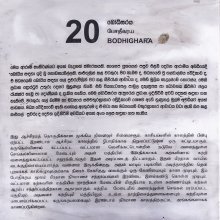Tabu: 2 definitions
Introduction:
Tabu means something in the history of ancient India, biology. If you want to know the exact meaning, history, etymology or English translation of this term then check out the descriptions on this page. Add your comment or reference to a book if you want to contribute to this summary article.
Images (photo gallery)
India history and geography
Source: Cologne Digital Sanskrit Dictionaries: Indian Epigraphical GlossaryTabu.—(IA 20, 29), a taboo. Note: tabu is defined in the “Indian epigraphical glossary” as it can be found on ancient inscriptions commonly written in Sanskrit, Prakrit or Dravidian languages.

The history of India traces the identification of countries, villages, towns and other regions of India, as well as mythology, zoology, royal dynasties, rulers, tribes, local festivities and traditions and regional languages. Ancient India enjoyed religious freedom and encourages the path of Dharma, a concept common to Buddhism, Hinduism, and Jainism.
Biology (plants and animals)
Source: Google Books: CRC World Dictionary (Regional names)Tabu in Philippines is the name of a plant defined with Symplocos cochinchinensis in various botanical sources. This page contains potential references in Ayurveda, modern medicine, and other folk traditions or local practices It has the synonym Dicalyx cochinchinensis Lour. (among others).
Example references for further research on medicinal uses or toxicity (see latin names for full list):
· FBI (1882)
· Flora Indica, or ‘Descriptions of Indian Plants’ (1832)
· Noot. Rev. Symploc. (1975)
· Flora Cochinchinensis (1790)
· Hortus Bengalensis, or ‘a Catalogue of the Plants Growing in the Hounourable East India Company's Botanical Garden at Calcutta’ (1814)
· Fl. Cambodge, Laos & Vietnam (1977)
If you are looking for specific details regarding Tabu, for example extract dosage, side effects, health benefits, diet and recipes, chemical composition, pregnancy safety, have a look at these references.

This sections includes definitions from the five kingdoms of living things: Animals, Plants, Fungi, Protists and Monera. It will include both the official binomial nomenclature (scientific names usually in Latin) as well as regional spellings and variants.
See also (Relevant definitions)
Starts with: Tabu kayu, Tabuchi, Tabugok, Tabuka, Tabuku, Tabulu, Tabum, Tabungau, Tabut, Tabuta, Tabuti, Tabutu, Tabuturu, Tabuva, Tabuyok, Tagulisu.
Ends with: Aphtabu, Balkutabu, Balutabu, Basit bantabu, Kitabu.
Full-text: Tabu kayu.
Relevant text
Search found 8 books and stories containing Tabu; (plurals include: Tabus). You can also click to the full overview containing English textual excerpts. Below are direct links for the most relevant articles:
Śrī Kṛṣṇa-vijaya (by Śrī Gunaraja Khan)
Chapter 8 - Indra's Prayers to Lord Kṛṣṇa (Pāhiḍā-rāga)
Chapter 6 - Prayers by the Wives of Kāliya-nāga (Dhānasi-rāga)
Chaitanya Bhagavata (by Bhumipati Dāsa)
Verse 3.3.50 < [Chapter 3 - Mahāprabhu’s Deliverance of Sarvabhauma, Exhibition of His Six-armed Form, and Journey to Bengal]
Verse 2.13.41 < [Chapter 13 - The Deliverance of Jagāi and Mādhāi]
Verse 2.1.294 < [Chapter 1 - The Beginning of the Lord’s Manifestation and His Instructions on Kṛṣṇa-saṅkīrtana]
Bhajana-Rahasya (by Srila Bhaktivinoda Thakura Mahasaya)
Text 1 < [Chapter 8 - Aṣṭama-yāma-sādhana (Rātri-līlā–prema-bhajana sambhoga)]
Text 31 < [Chapter 1 - Prathama-yāma-sādhana (Niśānta-bhajana–śraddhā)]
Text 9 < [Chapter 1 - Prathama-yāma-sādhana (Niśānta-bhajana–śraddhā)]
Folk Tradition of Bengal (and Rabindranath Tagore) (by Joydeep Mukherjee)
Shri Gaudiya Kanthahara (by Srila Bhaktisiddhanta Sarasvati)
Some Thoughts on the Veda and its Study < [January – March, 1978]
